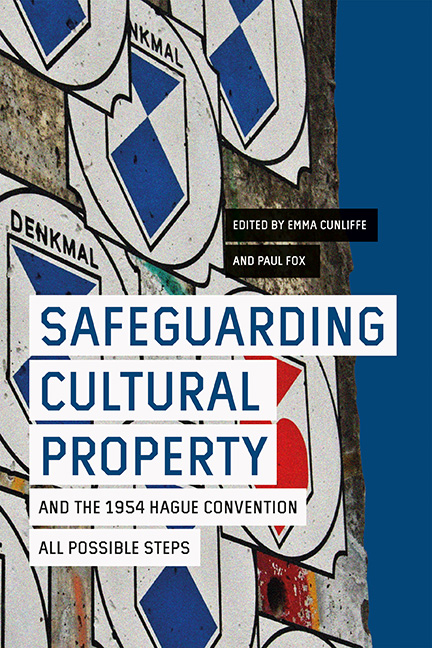Book contents
- Frontmatter
- Contents
- List of Illustrations
- List of Contributors
- Plate Section
- Acknowledgements
- List of Abbreviations
- Preface: The Blue Shield and the Protection of the World's Cultural Property – Preparing in Peace for Conflict
- Part I Safeguarding – Reassessing the Field
- Part II Historical Perspectives
- Part III Current Issues in Legal Implementation
- Part IV The Hague Convention in Practice Today: Tools and Approaches
- Appendix 1 The Hague Convention for the Protection of Cultural Property in the Event of Armed Conflict with Regulations for the Execution of the Convention 1954
- Appendix 2 Regulations for the Execution of the Convention for the Protection of Cultural Property in the Event of Armed Conflict
- Appendix 3 Resolutions of the 1954 Hague Conference
- Appendix 4 Second Protocol to the Hague Convention of 1954 for the Protection of Cultural Property in the Event of Armed Conflict 1999
- Appendix 5 Additional Protocols (1977) to the Geneva Conventions (1949) (Extracts)
- Index
- HERITAGE MATTERS
4 - Refuges, Safe Havens, and the Protection of Movable Cultural Heritage
Published online by Cambridge University Press: 26 May 2022
- Frontmatter
- Contents
- List of Illustrations
- List of Contributors
- Plate Section
- Acknowledgements
- List of Abbreviations
- Preface: The Blue Shield and the Protection of the World's Cultural Property – Preparing in Peace for Conflict
- Part I Safeguarding – Reassessing the Field
- Part II Historical Perspectives
- Part III Current Issues in Legal Implementation
- Part IV The Hague Convention in Practice Today: Tools and Approaches
- Appendix 1 The Hague Convention for the Protection of Cultural Property in the Event of Armed Conflict with Regulations for the Execution of the Convention 1954
- Appendix 2 Regulations for the Execution of the Convention for the Protection of Cultural Property in the Event of Armed Conflict
- Appendix 3 Resolutions of the 1954 Hague Conference
- Appendix 4 Second Protocol to the Hague Convention of 1954 for the Protection of Cultural Property in the Event of Armed Conflict 1999
- Appendix 5 Additional Protocols (1977) to the Geneva Conventions (1949) (Extracts)
- Index
- HERITAGE MATTERS
Summary
The 1954 Hague Convention for the Protection of Cultural Property in the Event of Armed Conflict (‘the Convention’) and its 1999 Second Protocol can grant protection to refuges intended to shelter movable cultural property (CP), providing the refuges and their contents with varying levels of immunity from acts of hostility and military use during conflicts. Despite its sweeping ratification around the globe (133 states parties at the time of writing), nations have been reticent to rely on the Convention's provisions to protect movable CP. Instead, safe havens have become the preferred international term, but there is a lack of clarity in their meaning, form, and the practices surrounding them, which we seek to clarify.
This article explores the legal regime of refuges under the Convention, its Regulations for Execution (‘Regulations’) and its 1999 Second Protocol (based solely on these treaties, rather than any specific national implementation laws), and their relationship with safe havens. States have granted safe haven to CP based on diverse general practices, antiquities laws, export controls, and rules and mechanisms of enforcement (Nafziger 2007), in addition to specific safe haven laws and guidance, hence the lack of clarity regarding them. We begin with a brief contextual overview of refuges and safe havens, before offering a more detailed comparison of their respective scopes and requirements. We subsequently discuss the interrelations of both systems of protection, before concluding by assessing each protective regime and the opportunities offered by their interrelation.
DEFINITIONS
Refuges, as laid out in the Convention, can be characterised as special venues for safeguarding movable CP during conflict. They are situated within the territory of High Contracting Parties to the Convention (HCP), and so are protected by international law; and the HCPs usually (but not always) own the CP.
Safe havens are temporary shelters created in one state to primarily (but not always, as shown below) house CP from a different country that is endangered due to a conflict or natural catastrophe. They are governed by the national law of their location, though they should accord due respect to the laws and traditions of the source state of cultural material (ILA Guidelines 4; UNESCO 2017a). Where specific national safe haven legislation exists, generally speaking, it enables state executive powers to create temporary shelters to house the endangered foreign CP.
- Type
- Chapter
- Information
- Safeguarding Cultural Property and the 1954 Hague ConventionAll Possible Steps, pp. 79 - 96Publisher: Boydell & BrewerPrint publication year: 2022



